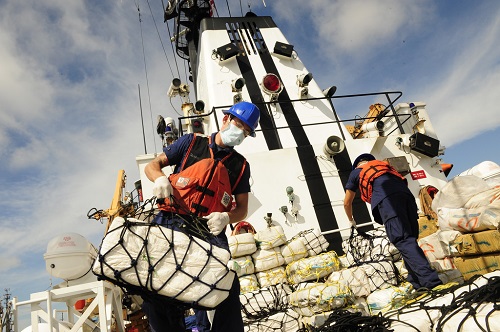USCG photo
By
Ricardo Swire
For the past decade Caribbean national security and counter-narcotics officials have been inundated by the onslaught of South and Central American drugs and guns traffic through the islands with an invidious impact. Caribbean islands have paid a high price for law enforcement successes elsewhere. As Mexico’s modified internal counter-narcotics mechanism squeezed the “narco balloon” it swelled eastward to neighbouring tropical islands. North-eastern Caribbean states such as Antigua, St Kitts & Nevis became popular alternative sea routes for cocaine originating from Central America’s Mosquita region.
Transnational drug cartels allied themselves to island gangs and established a unique payment system of guns and drugs, for consignment protection and smuggling services, mirroring the practice on Trinidad & Tobag. The 2011 Dominican Republic (DR) National Police operation that detained a local Sinaloa Cartel logistics officer verified the notorious Mexican criminal Syndicate’s activity in the Caribbean. The DR detainee coordinated several high-value cocaine aerial shipments from Venezuela.
St Kitts & Nevis, located two hundred and twenty-five miles southeast of Puerto Rico (PR), is a “jump point” for product en route to the United States Virgin Islands and PR. The Caribbean’s Twin Island Federation, sitting on the Leeward Islands’ northern end, is challenged by aggressive local drug syndicates comprised of Jamaican trained marijuana smugglers with Colombian drug cartel links. In March 2012 at a meeting in SVG the Regional Security System’s Council of Ministers plus American, Canadian and French government officials made commitments to collectively assist the Caribbean fight against trans-national crime and trafficking.
In the first half of 2013 the US Drug Enforcement Administration (DEA) estimated fourteen percent of cocaine shipments smuggled to America travelled via the Caribbean, twice the previous year’s recorded total. In December 2013 DR counter-narcotics agents registered the interceptions of ninety-one metric tons, or the Caribbean’s largest cocaine flow since 2003. 2014 US DEA Caribbean division statistics tripled the regional transiting cocaine tally, from five percent to sixteen percent. Traffickers moved between ninety and one hundred tons via the Caribbean, seventy tons more than previous years.
The 2015 DEA National Drug Threat Assessment indicated that regional cocaine smuggling routes started on the Caribbean coasts of Colombia, Honduras, Panama and Venezuela. Traffickers maximised the use of long, narrow, high-speed, watercraft aka “Cigarette Boats” to move four thousand pound cocaine loads each journey. Since 2011 Venezuelan networks have fostered close relationships with Barbados based traffickers which facilitate product movements. Secret meetings, between Venezuelan and Barbadian underworld partners, were convened to arrange deliveries.
2010 was the first time three different cocaine types or liquid, powdered and crystalline, were seized by Royal Barbados Police Force (RBPF) Drug Squad detectives. Venezuelan cocaine consignments are usually jettisoned from foreign-flagged ships at predestined Global Positioning System coordinates and collected by local watercrafts in territorial waters, under the cover of night. The maritime method casts a dark shadow over vessel identification and challenges Barbados’ Inter-Costal Surveillance System Radar detection capability.
Barbados maximizes the use of RSS HQ resources and shared data from member states, as part of the island’s anti-drug strategy. Officials also partner with American, Canadian and British law enforcement agencies to conduct enforcement operations. In September 2017 Caribbean intelligence data noted how St Vincent & the Grenadines (SVG) drug trafficking culture’s modus operandi was dramatized by the alarming murder of a young woman. An unidentified heavily armed female gang invaded the victim’s home, killing her in full view of family.
In October 2017 SVG’s drug turf conflict boiled over after four masked gunmen fired forty bullets, wounding seven and killing one patron in the Road Side Bar, at Diamond Village on the island’s windward side. Royal SVG Police data stated the gunmen arrived in vehicles without number plates, exited, directly approached and shot targeted individuals before walking back to the vehicles. A brutal delivery of the message that SVG’s Diamond district’s drug market was considered contested territory.
Ricardo Swire
Ricardo Swire is the Principal Consultant at R-L-H Security Consultants & Business Support Services and writes on a number of important issues.



No Comments Yet!
You can be first to comment this post!